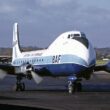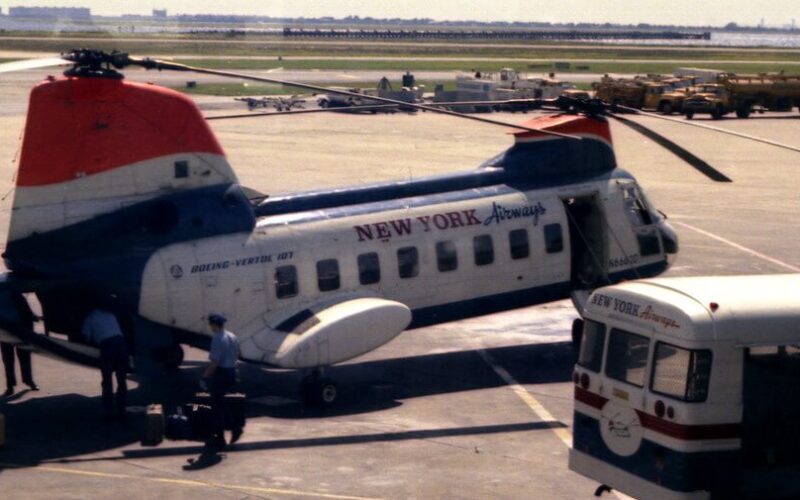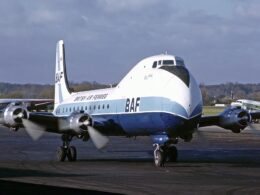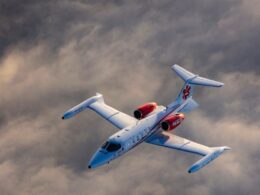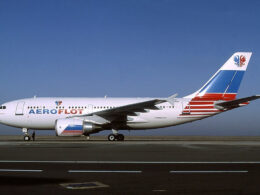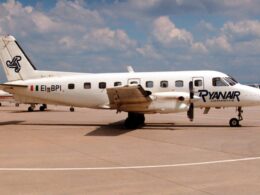We all hate traffic. Nobody likes sitting in their cars or public transport for hours every week just to get to their destination.
But one company provided a very obvious, yet outrageous solution – flying over traffic. On this day, July 8, 1953, New York Airways began its helicopter passenger services. The first route was between New York International Airport (now called John F. Kennedy International Airport, JFK), New York LaGuardia (LGA) and Newark Airport (EWR), served with a military converted Sikorsky S-55.
Right circumstances for New York Airways
In 1953, American citizens owned over 56 million motor vehicles in the United States, according to old documents found in the Department of Transport archives. Over 6 million of them were registered in New York and New Jersey, locations of the three airports that New York Airways started serving in 1953.
Air travel was picking up pace as well. Just a year before, in 1952, BOAC started the first commercial flight of a passenger aircraft with a jet engine – the Comet.
R.L. Cummings Jr, the president of the company, used the opportunity perfectly – he offered passengers the option to transfer between airports and go above traffic. And to do so quickly, as the journey between the three New York airports took just an hour and thirteen minutes, according to an old Flight magazine.
New York Airways had its fair share of supporters. Flyers enjoyed the opportunity to travel on scenic routes that overlooked Manhattan, the Liberty Statue and other New York monuments. The flight from the Pan Am building at the heart of Manhattan to JFK airport took just seven minutes and passengers paid only $7 for the journey. Adjusted for inflation, the ticket would set you back $56 in today’s prices.
At the same time, it had a lot of opposition – residents were angry about the noise from the rotors of the helicopters. Safety was a concern too – in an event of a crash, not only the passengers and the crew of a helicopter would be endangered, but pedestrians on the ground as well.
Safety concerns came to fruition in 1977, when five people died after a New York Airways helicopter crashed following a fractured right front landing gear.
Eventually, in 1979, New York Airways shut down forever. The company filed bankruptcy after a deadly accident the same year that claimed the lives of three passengers.
A cultural icon
When the Pan Am building opened in 1963 with a heliport on its roof that became operational in 1965, the New York Airways and Pan Am names became an integral part of the culture within the city.
Even a Hollywood film, Coogan’s Bluff featured the helicopter ride onboard New York Airways with a young Clint Eastwood, portraying a veteran deputy sheriff that’s on the lookout for an escapee.
Passengers also enjoyed a fairly low price on the helicopter ride, a ride that was much faster and cheaper than a taxi.
The Port Authority of New York and New York Airways had huge plans for the future of helicopter travel within the Big Apple at an age where commercial jetliners were just making their first steps. New heliports in Brooklyn, The Battery, East Side of Manhattan, Staten Island and Newark were in the plans.
Anyhow, New York Airways became both a cultural icon and an inspiration for others. Companies like Sabena, Los Angeles Airways, British European Airways and Chicago Helicopter Airways started their services months within the first flight of New York Airways. All of these companies became the pioneers of urban mobility, revolutionizing the way people reached their destinations within cities.
In its first year, the helicopter airline carried 8758 passengers. Almost ten years later, in 1963, NYA carried more than 250 000 passengers.
However, a dark sky gathered over the office of New York Airways. There were always doubts about whether the helicopter airline could sustain its business and whether the service is even safe.
Unfortunately, these doubts became a reality for New York Airways.
Trouble in New York
The same year that the helicopter airline reported a record amount of passengers, NYA also endured their first accident. Shortly after taking off from New York International Airport, a Boeing Vertol 107-II registered N6673D crashed. The crash claimed the lives of six people – three crew members and three passengers have passed away, reported by the NTSB.
The report outlined the first issue of the airline. As the NTSB determined the crash was related to fatigue to the main rotor shaft and contaminated oil, maintenance procedures during the operations of New York Airways were questioned.
The first shuttle services that New York Airways started between three New York airports had a very small window of the turnover period. The airline ran a 24/7 service, with sixteen daily flights in 90-minute intervals. When preparing the helicopters, the airline designated a 15-minute break to refuel. So, the last flight of the day arrived at half-past midnight at La Guardia (LGA) airport. The service resumed just 15 minutes later, a quarter to 1 AM.
Thus, leaving no time for proper maintenance and inspection after a day’s worth of flights. For example, low-cost carriers that also rely on fast turn arounds during the day to serve passengers, return their aircraft to their designated bases for maintenance during the night. Thus, the no-frills airlines can ensure a safe operating condition of the aircraft.
Secondly, the airline‘s passenger service was in a paradox. As the airline carried more passengers, New York Airways‘ costs rose significantly. In 1962, the total revenue of New York Airways was estimated to be $3.9 million. The costs to run the operations – $4.4 million. The airline was operating under a constant loss – its only saving grace was the fact that the government heavily subsidized the operations.
But the United States government pulled the carpet from under every helicopter airline feet. The government announced in 1965 that it will eventually end the subsidies towards airlines like New York Airways, Los Angeles Airways and Chicago Helicopter Airways.
The first victim was Chicago Helicopter Airways. At the beginning of 1966, the airline ended regularly scheduled services, citing that “it would lose about $3000 per day without a subsidy”.
Fortunately, New York Airways had the backing of Pan American. The airline was heavily interested in the helicopter service. So much so, that Pan Am bought two Boeing Vertol 107-II helicopters and leased them to NYA.
As a result of the interest from Pan Am, the helicopter airline of New York could stay in business.
Pan American building incident
But New York Airways brought something very unwanted to Pan Am – an accident that damaged the image of helicopter travel within a city permanently.
However, even before the infamous 1977 accident, the helicopter airline was struggling. Already in 1965, Trans World Airlines offered a financial help package for NYA.
Amidst financial trouble, Pan Am was already thinking about selling their 45% stake in New York Airways in 1970. A year before, in 1969, Pan Am loaned $400.000 to the helicopter airline.
The sale plan did not go through, as, by 1975, Pan Am still held a stake at NYA. Albeit, a smaller one – 43%.
New York Airways encountered financial issues after the 1973 oil crisis. As oil prices quadrupled, so did the operating costs. Without the subsidy to cover the increased fuel prices, the airline was losing a lot of money.
Nevertheless, NYA limped on.
Until May 16th, 1977. A New York Airways Sikorsky S-61L, operating as Flight 971 from John F. Kennedy Airport (JFK) to the rooftop of the Pan American Building at the heart of Manhattan rolled over while passengers were boarding the helicopter. Four passengers died instantly. In addition, a falling rotor blade struck a woman while she was walking on Madison and 43rd Street, killing her instantly. In total, the Pan Am Building accident claimed the lives of 5 people.
The NTSB report determined that metal fatigue of the right-side landing gear caused the helicopter to balance over and the still-active rotor blades snapped off.
As a result of the accident, the route that connected Manhattan with New York’s airports closed. Furthermore, NYA sued Sikorsky for $30 million.
But the airline did not recover.
Final nail
Its final nail in the coffin came in April of 1979 when another helicopter suffered a fatigue-related accident. This time, one of the tail-rotor blades broke-off and as a result, a Sikorsky 5-61 crashed at Newark International Airport (EWR).
Three passengers died on the spot, ten more passengers and three crew members sustained serious injuries.
New York Airways immediately halted all services. On May 16th, 1979 the helicopter airline filed for Chapter XI bankruptcy protection and tried to come up with a plan to resume services.
Firstly, they increased their claims from Sikorsky from $30 million after the Pan Am building accident to $65 million in total.
Secondly, they sold their remaining Sikorsky helicopters and searched for a new manufacturer to provide them with the aircraft needed to resume operations.
But NYA’s plan failed. Sikorsky agreed to pay for the damages, but NYA only received $6 million instead of the $65 million that the airline sued for.
The money that New York Airways received was enough to cover some of the debts to creditors. However, not a single helicopter carrying New York Airways lifted off from the ground since the 1979 accident at Newark (EWR) and the airline ceased to exist.
What’s NeXt?
Nevertheless, New York Airways not only inspired its helicopter airline counterparts in Chicago and Los Angeles, but it also inspired the minds of today to re-think urban mobility.
Projects like Boeing NeXt, Airbus Urban Mobility and Uber are exploring solutions to one of the biggest problems in big cities like New York – traffic.
While such projects have only made their first baby steps and are only now engaged in their first test flights, the future seems bright for the Flying Taxis.
Less complex maintenance procedures, electricity replacing fuel and computers replacing pilots can make flying above the city streets a reality once more. However, there are a lot of more steps to take before it can truly fill the gap left by New York Airways and other helicopter airlines.

